The NVIDIA GeForce GTX Titan X Review
by Ryan Smith on March 17, 2015 3:00 PM ESTMiddle Earth: Shadow of Mordor
Our next benchmark is Monolith’s popular open-world action game, Middle Earth: Shadow of Mordor. One of our current-gen console multiplatform titles, Shadow of Mordor is plenty punishing on its own, and at Ultra settings it absolutely devours VRAM, showcasing the knock-on effect of current-gen consoles have on VRAM requirements.
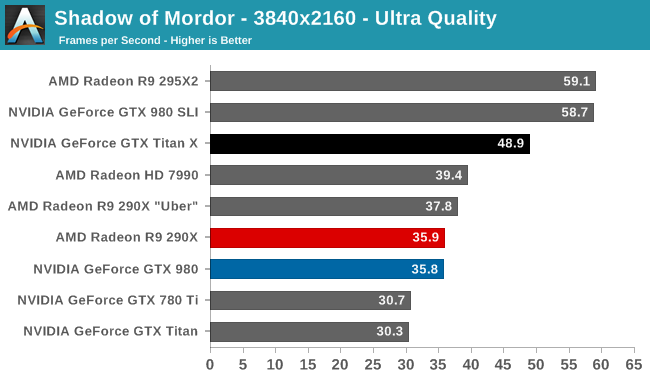
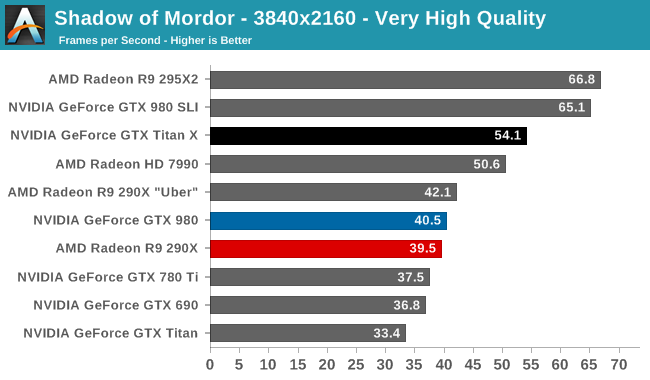
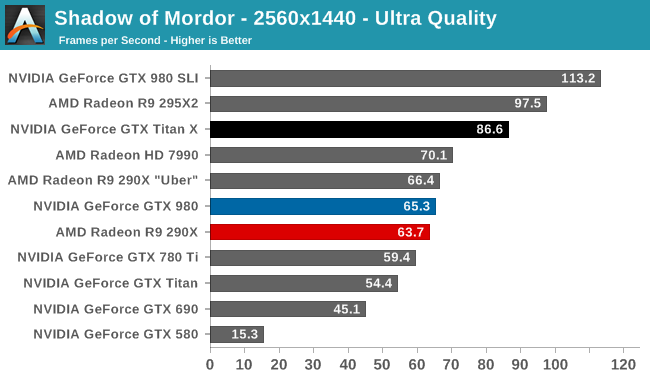
Once again even GTX Titan X won’t be enough for 60fps at 4K, but at 48.9fps it’s closer to 60fps than 30fps, representing a significant improvement in 4K performance in only a generation. Compared to the GTX 980 and NVIDIA’s other cards the GTX Titan X is once more in a comfortable lead, overtaking its smaller sibling by around 33% and the older GK110 cards at 45-60%.
Turning down the game’s quality settings to Very High does improve performance a bit, but at 54.1fps it’s still not quite enough for 60fps. The biggest advantage of Very High quality is alleviating some of the high VRAM requirements, something the GTX Titan cards don’t suffer from in the first place. Otherwise dropping to 1440p will give us a significant bump in performance, pushing framerates over 80fps once again.
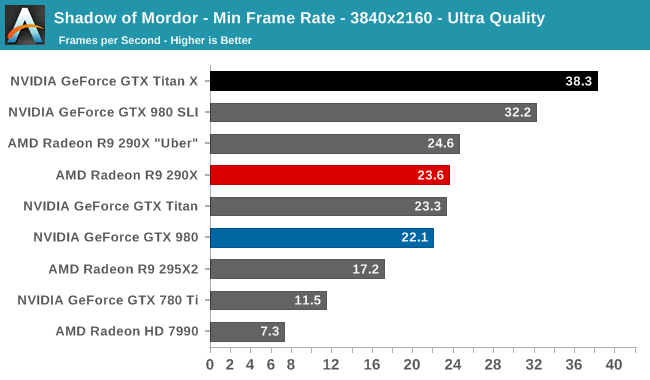

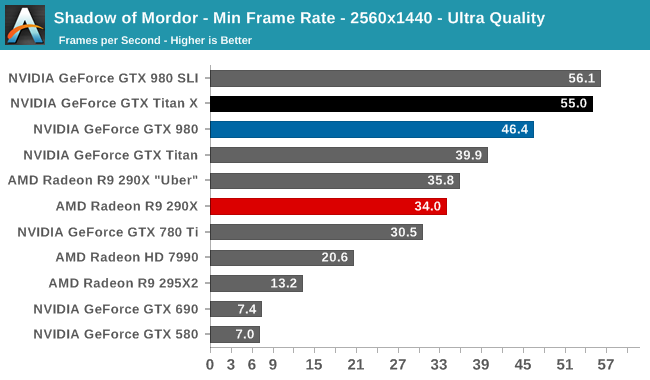
Meanwhile the game’s minimum framerate further elaborates on the performance hit from the game’s high VRAM usage at Ultra quality. 3GB cards collapse here, leaving the 4GB cards and the 6GB original Titan much higher in our charts. Multi-GPU performance also struggles here, even with 4GB cards, reminding us that while multi-GPU setups can be potent, they do introduce performance consistency issues that single-GPU cards can avoid.










276 Comments
View All Comments
Denithor - Wednesday, March 18, 2015 - link
Correct, but then they should have priced it around $800, not $1k. The reason they could demand $1k for the original Titan was due to the FP64 compute functionality on board.This is exactly what they did when they made the GTX 560 Ti, chopped out the compute features to maximize gaming power at a low cost. The reason that one was such a great card was due to price positioning, not just performance.
chizow - Monday, March 23, 2015 - link
@Denithor, I disagree, the reason they could charge $1K for the original Titan was because there was still considerable doubt there would ever be a traditionally priced GeForce GTX card based on GK110, the compute aspect was just add-on BS to fluff up the price.Since then of course, they released not 1, but 2 traditional GTX cards (780 and Ti) that were much better received by the gaming market in terms of both price and in the case of the Ti, performance. Most notably was the fact the original Titan price on FS/FT and Ebay markets quickly dropped below that of the 780Ti. If the allure of the Titan was indeed for DP compute, it would have held its price, but the fact Titan owners were dumping their cards for less than what it cost to buy a 780Ti clearly showed the demand and price justification for a Titan for compute alone simply wasn't there. Also, important to note Titan's drivers were still GeForce, so even if it did have better DP performance, there were still a lot of driver limitations related to CUDA preventing it from reaching Quadro/Tesla levels of performance.
Simply put, Nvidia couldn't pull that trick again under the guise of compute this time around, and people like me who weren't willing to pay a penny for compute over gaming weren't willing to justify that price tag for features we had no use for. Titan X on the other hand, its 100% dedicated to gamers, not a single transistor budgeted for something I don't care about, and no false pretenses to go with it.
Samus - Thursday, March 19, 2015 - link
The identity crisis this card has with itself is that for all the effort, it's still slower than two 980's in SLI, and when overclocked to try to catch up to them, ends up using MORE POWER than two 980's in SLI.So for the price (being identical) wouldn't you just pick up two 980's which offer more performance, less power consumption and FP64 (even if you don't need it, it'll help the resell value in the future)?
LukaP - Thursday, March 19, 2015 - link
The 980 have the same 1/32 DP performance as the Titan X. And Titan never was a sensible card. Noone sensible buys it over a x80 of that generation (which i assume will be 1080 or whatever they call it, based on GM200 with less ram, and maybe some disabled ROPs).The Titan is a true flagship. making no sense economically, but increasing your penis size by miles
chizow - Monday, March 23, 2015 - link
I considered going this route but ultimately decided against it despite having used many SLI setups in the past. There's a number of things to like about the 980 but ultimately I felt I didn't want to be hamstrung by the 4GB in the future. There are already a number of games that push right up to that 4GB VRAM usage at 1440p and in the end I was more interested in bringing up min FPS than absolutely maxing out top-end FPS with 980 SLI.Power I would say is about the same, 980 is super efficient but once overclocked, with 2 of them I am sure the 980 set-up would use as much if not more than the single Titan X.
naxeem - Saturday, March 21, 2015 - link
You're forgetting three things:1. NO game uses even close to 8GB, let alone 12
2. $1000/1300€ puts it to exactly double the price of exactly the same performance level you get with any other solution: 970 SLI kicks it with $750, 295x2 does the same, 2x290X also...
In Europe, the card is even 30% more expensive than in US and than other cards so even less people will buy it there.
3. In summer, when AMD releases 390X for $700 and gives even better performance, Nvidia will either have to drop TitanX to the same price or suffer being smashed around at the market.
Keep in mind HBM is seriously a performance kicker for high resolutions, end-game gaming that TitanX is intended for. No amount of RAM can counter RAM bandwidth, especially when you don't really need over 6-7GB for even the most demanding games out there.
ArmedandDangerous - Saturday, March 21, 2015 - link
Or they could just say fuck it and keep the Titan at it's exact price and release a x80 GM200 at a lower price with some features cut that will still compete with whatever AMD has to offer. This is the 3rd Titan, how can you not know this by now.naxeem - Tuesday, March 24, 2015 - link
Well, yes. But without any compute performance of previous Titans, who would any why buy a 1000 Titan X while having exact same performance in some 980Ti or alike?Those who need 12GB for rendering may as well buy Quadros with more VRAM... When you need 12, you need more anyway... For gaming, 12GB means jack sht.
Thetrav55 - Friday, March 20, 2015 - link
Well its only the fastest card in the WORLD look at it that way the fattest card in the world ONLY 1000$ I know I know 1000 does not justify the performance but its the fastest card in the WORLD!!!agentbb007 - Wednesday, June 24, 2015 - link
LOL had to laugh @ farealstarfareal's comment that the 390X would likely blow the doors off the Titan X, the 390X is nowhere near the Titan X, it's closer to a 980. The all mighty R9 FuryX reviews posted this morning and it's not even beating the 980ti.